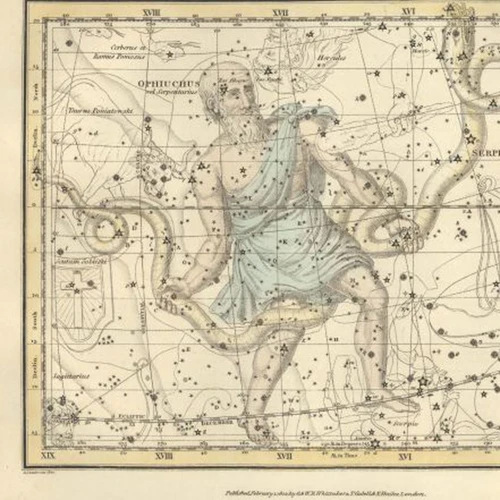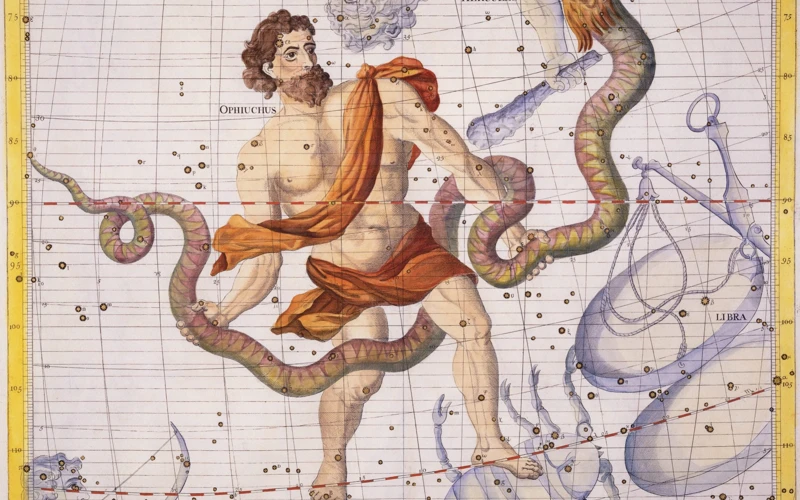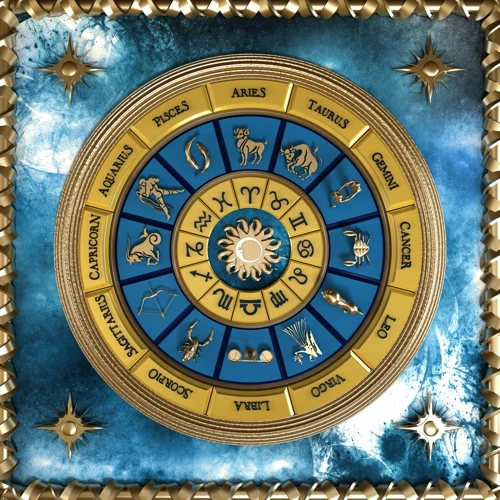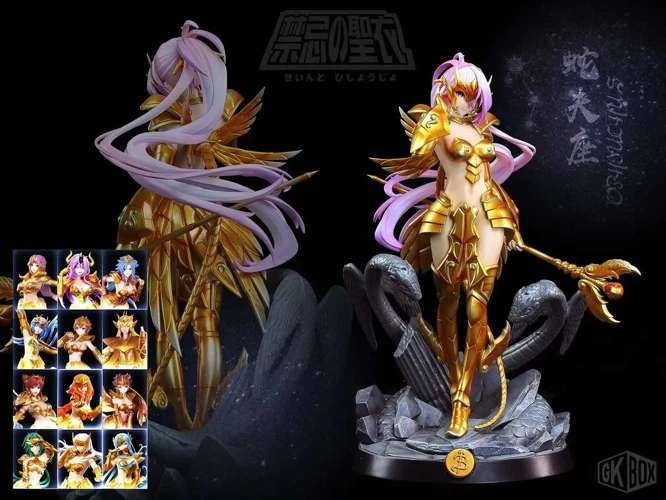The mysterious constellation of Ophiuchus has captivated astronomers, astrologers, and writers throughout history. Beyond the traditional twelve zodiac signs, Ophiuchus represents the serpent-bearer, a figure entwined with symbolism and mythological significance. In this article, we will delve into the world of literature to explore the presence of Ophiuchus in classical and contemporary works. From ancient epics to modern science fiction, Ophiuchus plays a unique and enigmatic role, captivating readers with its elusive charm. Join us on this literary journey as we unravel the secrets of Ophiuchus and its intriguing portrayal in books and characters.
Contents
- Ophiuchus in Classical Literature
- Ophiuchus in Contemporary Literature
- Ophiuchus as a Symbolic Character
- Ophiuchus in Modern Science Fiction
- Conclusion
-
Frequently Asked Questions
- 1. How does Ophiuchus differ from the traditional zodiac signs?
- 2. What is the mythology behind Ophiuchus?
- 3. Are people born under the sign of Ophiuchus different from others?
- 4. Are there any famous literary characters associated with Ophiuchus?
- 5. Can Ophiuchus be seen in the night sky?
- 6. Is Ophiuchus mentioned in other ancient texts?
- 7. Does Ophiuchus have any specific symbolism in astrology?
- 8. Are there any contemporary novels that feature Ophiuchus?
- 9. What is the significance of Ophiuchus in the context of knowledge and medicine?
- 10. Are there any scientific theories or discoveries related to Ophiuchus?
- References
-
Frequently Asked Questions
- What is Ophiuchus in literature?
- Are there any ancient texts that mention Ophiuchus?
- Which modern novels feature Ophiuchus as a prominent character?
- What is the significance of Ophiuchus as a symbolic character?
- Is Ophiuchus present in modern science fiction literature?
- What role does Ophiuchus play in “The Odyssey” by Homer?
- In “Metamorphoses” by Ovid, how is Ophiuchus represented?
- What connection does Ophiuchus have with “Dante’s Inferno” by Dante Alighieri?
- How is Ophiuchus portrayed in “The Alchemist” by Paulo Coelho?
- Which character from “The Girl with the Dragon Tattoo” by Stieg Larsson embodies Ophiuchus traits?
- References
- Read More
Ophiuchus in Classical Literature

In the realm of classical literature, references to Ophiuchus can be found in several renowned works. One notable example is The Odyssey by Homer, where the serpent-bearer is mentioned in the context of the constellations. The protagonist, Odysseus, encounters a series of challenges and trials during his long voyage home, and the celestial presence of Ophiuchus adds a mystical dimension to his journey. Another fascinating depiction can be found in Metamorphoses by Ovid, where Ophiuchus is associated with the story of Asclepius, the Greek god of medicine. Asclepius, represented by the serpent-entwined staff, exemplifies healing and resurrection, making Ophiuchus a symbol of both knowledge and transformation. Additionally, Dante’s Inferno by Dante Alighieri includes a brief but significant reference to Ophiuchus. As the protagonist descends into the circles of Hell, he glimpses the constellation, symbolizing the transition from the material world to the spiritual realm. These classical literary works intertwine Ophiuchus with themes of journey, healing, and transcendence, adding depth and intrigue to their narratives. To further explore the mythical origins of Ophiuchus, one can delve into /the-legend-of-imhotep-ophiuchus-in-ancient-egyptian-mythology/.
The Odyssey by Homer
In The Odyssey by Homer, the mention of Ophiuchus adds an intriguing celestial element to the epic tale. As the hero Odysseus embarks on his perilous journey home after the Trojan War, he encounters numerous challenges and obstacles. One notable encounter involves Odysseus sailing past the mighty Scylla and the treacherous Charybdis. It is during this part of the story that Ophiuchus is briefly referenced alongside other constellations. The inclusion of Ophiuchus, the serpent-bearer, among the celestial imagery in The Odyssey serves to emphasize the mystical and otherworldly nature of Odysseus’ odyssey. The serpent-bearer represents a connection between the earthly and divine realms, symbolizing not only the challenges and dangers that Odysseus faces but also his ability to navigate the realms of gods and mortals. Ophiuchus, with its enigmatic presence in The Odyssey, adds depth and intrigue to the narrative, reminding readers of the cosmic forces at play in the hero’s journey. To explore more about celestial phenomena and their mysteries, such as /unraveling-mystery-black-hole-mergers/ and /comets-astrobiology/, one can venture further into the realms of astrophysics and astrobiology.
Metamorphoses by Ovid
In Metamorphoses by Ovid, the inclusion of Ophiuchus is intertwined with the story of Asclepius, the Greek god of medicine and healing. Asclepius is depicted as holding a staff entwined with a serpent, a symbol that is strongly associated with Ophiuchus. The snake itself represents both life and death, as well as transformation and renewal, reflecting the healing abilities of Asclepius. Ovid’s narrative explores various myths and transformations, and the presence of Ophiuchus adds another layer of symbolism and intrigue to these tales. Ophiuchus represents the eternal cycles of life and death, serving as a reminder of the delicate balance between mortality and immortality. Through the mythological figures and their connections to Ophiuchus, Ovid offers a profound exploration of human nature and the transformative power of divine forces. The inclusion of Ophiuchus in Metamorphoses embellishes the narrative with its mystical and enigmatic qualities, captivating readers with its symbolical depth and resonance.
Dante’s Inferno by Dante Alighieri
In Dante Alighieri’s epic poem, Dante’s Inferno, the presence of Ophiuchus is brief but significant. As the protagonist, Dante, embarks on his journey through the nine circles of Hell, he encounters various celestial and mythological figures along the way. In Canto XX, Dante describes finding himself in the eighth circle, specifically in the section known as the Malebolge, which is dedicated to fraudulent activities. Here, he encounters the spirit of Vanni Fucci, a notorious thief. As Dante looks up at the night sky, he notices the constellation Ophiuchus, its serpent-bearer figure a reminder of both sin and redemption. The presence of Ophiuchus in this moment symbolizes the transition from the earthly realm to the spiritual or divine realm. It serves as a reminder to Dante of the consequences of his actions and the path he must traverse to achieve spiritual enlightenment. Thus, Ophiuchus in Dante’s Inferno adds an additional layer of symbolism and complexity to the narrative, emphasizing the overarching theme of judgment and the consequences of one’s choices.
Ophiuchus in Contemporary Literature

Ophiuchus continues to make its mark in contemporary literature, with authors incorporating its symbolism and themes into their works. One notable novel where Ophiuchus plays a prominent role is The Secret History by Donna Tartt. The protagonist, Richard Papen, becomes enthralled with a group of eccentric classics students whose lives take a dark and mysterious turn. Ophiuchus is subtly woven into the narrative, representing hidden knowledge and the looming presence of fate. Another intriguing example is The Alchemist by Paulo Coelho, where the protagonist embarks on a spiritual journey in search of his personal legend. Ophiuchus manifests as a symbol of transformation and discovery, as the main character learns to navigate the challenges of life in pursuit of his true purpose. In The Girl with the Dragon Tattoo by Stieg Larsson, the enigmatic character Lisbeth Salander exhibits traits commonly associated with Ophiuchus, such as resilience, intuition, and healing. Her complex personality and ability to navigate the shadows make her a captivating embodiment of the serpent-bearer’s archetype. These contemporary literary works demonstrate how Ophiuchus continues to inspire authors to explore themes of knowledge, transformation, and the pursuit of truth in unique and compelling ways.
The Secret History by Donna Tartt
In The Secret History by Donna Tartt, Ophiuchus makes a subtle yet intriguing appearance. The novel follows a group of eccentric classics students at an elite New England college. The main character, Richard Papen, becomes embroiled in a dark and secretive world as he becomes a member of this exclusive group. While the mention of Ophiuchus is not explicit, it is subtly woven into the narrative through the character Julian Morrow, the enigmatic Classics professor who teaches the students. Julian embodies the archetype of Ophiuchus, the serpent-bearer, with his deep knowledge and wisdom. Like Ophiuchus, he holds secrets and possesses the power to transform the lives of those around him. The symbolism of Ophiuchus in the novel reflects the theme of hidden knowledge and the blurred lines between morality and obsession. As readers navigate through the intricacies of the plot, they are reminded of the mysterious and complex nature of this celestial constellation. The incorporation of Ophiuchus in The Secret History adds an extra layer of depth and mystique to an already captivating and thought-provoking narrative.
The Alchemist by Paulo Coelho
In The Alchemist by Paulo Coelho, the theme of Ophiuchus is subtly interwoven into the story. The novel follows the journey of Santiago, a young Andalusian shepherd boy who embarks on a quest to find his personal legend. Throughout his travels, Santiago encounters various characters who impart profound wisdom and guidance. One of these characters is Melchizedek, the King of Salem. Melchizedek introduces Santiago to the concept of the Personal Legend, the path that each individual is destined to follow in order to fulfill their true purpose. In the book, Melchizedek presents Santiago with an amulet featuring the symbol of a snake swallowing its own tail, known as the Ouroboros. This symbol is associated with Ophiuchus and represents eternity, cycles of life, and the unity of opposing forces. The presence of Ophiuchus in The Alchemist serves as a reminder to Santiago of the importance of embracing one’s destiny and the eternal nature of the journey. It symbolizes the need to shed old beliefs and transform oneself in order to reach one’s true potential. Coelho’s masterful incorporation of Ophiuchus adds depth and philosophical layers to the already captivating narrative, making The Alchemist a thought-provoking exploration of personal growth and self-discovery.
The Girl with the Dragon Tattoo by Stieg Larsson
In the realm of contemporary literature, one remarkable example that incorporates Ophiuchus into its narrative is The Girl with the Dragon Tattoo by Stieg Larsson. This gripping thriller introduces Lisbeth Salander, a complex and enigmatic character known for her exceptional computer hacking skills and unwavering determination. Throughout the story, Salander displays traits that align with the symbolic qualities often associated with Ophiuchus. She embodies resilience, intelligence, and a mysterious allure that keeps readers captivated. Salander’s journey, intertwined with themes of justice, revenge, and personal growth, mirrors the transformative nature of Ophiuchus. The serpent-bearer’s influence, while not explicitly mentioned in the novel, can be felt through Salander’s strength, resourcefulness, and ability to overcome obstacles. Like Ophiuchus, she is a symbol of unyielding resilience and hidden power, making her portrayal in The Girl with the Dragon Tattoo a compelling exploration of the constellation’s timeless significance.
Ophiuchus as a Symbolic Character

In the realm of literature, Ophiuchus often transcends its astronomical significance and takes on the role of a symbolic character. One notable example comes from E.M. Forster’s novel, A Room with a View, where the character George Emerson embodies the traits associated with Ophiuchus. George is depicted as a free-spirited and unconventional individual who challenges societal norms. His rebellious nature and willingness to defy expectations align with Ophiuchus’ association with transformation and breaking boundaries. Another example can be found in the beloved science-fiction series Doctor Who, where the Doctor himself represents the essence of Ophiuchus. The Doctor, a time-traveling alien with regenerative powers, encompasses the healing and transformative qualities attributed to the serpent-bearer constellation. The character’s compassionate nature and constant quest for knowledge parallel the themes associated with Ophiuchus. Furthermore, The Lucifer Effect by Philip Zimbardo introduces Alexander Lucifer, a fictional character who symbolizes the duality of Ophiuchus. Lucifer, portrayed as a complex and morally ambiguous figure, embodies both the potential for healing and the temptation of darkness. These symbolic representations of Ophiuchus in literature highlight its versatility as a character archetype, offering readers a glimpse into the enigmatic nature of the serpent-bearer.
George Emerson from A Room with a View by E.M. Forster
In E.M. Forster’s novel, A Room with a View, George Emerson stands out as a symbolic character associated with Ophiuchus. George embodies the transformative and rebellious nature often attributed to this constellation. He defies societal conventions and challenges the rigid Victorian values of his time. George is characterized as a free spirit who embraces his passions and follows his own moral compass. His connection to Ophiuchus becomes apparent through his desire for spiritual growth and his ability to heal emotional wounds. Just as Ophiuchus represents the serpent-bearer, George carries the metaphorical burden of truth and authenticity in a world that stifles individualism. By embracing his true self, George becomes a catalyst for change and liberation, leaving a lasting impact on both the characters within the novel and the readers themselves. Through the enigmatic portrayal of George Emerson, E.M. Forster displays the transformative power that Ophiuchus represents in contemporary literature.
The Doctor from Doctor Who
One of the most iconic and beloved characters associated with Ophiuchus in contemporary literature is none other than The Doctor from the long-running television series, Doctor Who. The Doctor, a Time Lord from the planet Gallifrey, is a complex and enigmatic figure who travels through time and space in their trusty TARDIS. Throughout the show’s history, Ophiuchus has been referenced in the context of The Doctor’s astrological sign, symbolizing their unique and unconventional nature. The Doctor, often portrayed as a guardian and protector of the universe, embodies the traits typically associated with Ophiuchus: wisdom, healing, and the ability to bring about change. The Doctor’s constant evolution and regeneration mirror the transformative nature of Ophiuchus, as they reincarnate into a new form each time they face mortal peril. The Doctor’s timeless adventures and their alignment with the symbol of Ophiuchus make them an intriguing and multidimensional character in the world of contemporary literature.
Alexander Lucifer from The Lucifer Effect by Philip Zimbardo
In the thought-provoking book The Lucifer Effect by Philip Zimbardo, the character Alexander Lucifer serves as a symbolic representation of the dark side of human nature. The name itself, a combination of the Greek “Alexander,” meaning defender of humanity, and “Lucifer,” the fallen angel associated with evil, highlights the complex duality within him. Throughout the book, Alexander Lucifer embodies the corrupting influence of power and the potential for moral degradation. Zimbardo explores the concept of situational forces and how they can lead ordinary individuals to commit unspeakable acts. Alexander Lucifer’s character becomes a metaphorical vessel for examining the depths to which human beings can sink when placed in extreme circumstances. As readers delve into the depths of The Lucifer Effect, they are prompted to reflect on the fragile balance between good and evil within themselves and society as a whole. This introspective exploration intertwines the enigmatic nature of Ophiuchus as a symbol with the philosophical questions raised by the character Alexander Lucifer.
Ophiuchus in Modern Science Fiction

Ophiuchus continues to make its mark in the realm of modern science fiction, captivating readers with its enigmatic presence. One notable example of Ophiuchus in modern science fiction is the The Expanse series by James S.A. Corey. This popular book series features a futuristic world where Ophiuchus plays a key role. The constellation’s significance is connected to the Belters, a marginalized group living in the asteroid belt between Mars and Jupiter. Ophiuchus represents rebirth and transformation, reflecting the Belters’ struggle for independence and self-realization. Another noteworthy mention is the Foundation series by Isaac Asimov, in which Ophiuchus appears as part of the galactic empire’s astrological system. The presence of Ophiuchus adds an element of mysticism and foreshadows major events in the story. And let’s not forget The Hitchhiker’s Guide to the Galaxy by Douglas Adams, where Ophiuchus is humorously depicted as a sign in the zodiac that nobody bothers to pay attention to, highlighting the eccentricity and absurdity of the book’s universe. These modern science fiction works demonstrate the versatility and intrigue of Ophiuchus, making it a fascinating element in the genre.
The Expanse series by James S.A. Corey
In the realm of contemporary literature, the Expanse series by James S.A. Corey offers a captivating science fiction saga that prominently features Ophiuchus. Set in a future where humanity has colonized the solar system, the series follows a diverse cast of characters as they navigate political conflicts, interplanetary tensions, and thrilling space adventures. Ophiuchus plays a significant role in this expansive universe, serving as the name of a major space station situated in the asteroid belt between Mars and Jupiter. Described as a hub of trade, diplomacy, and intrigue, Ophiuchus Station becomes a central setting for various plotlines throughout the series. The authors skillfully weave the symbolism of the serpent-bearer into the narrative, using it to represent the complex interplay of power, manipulation, and hidden agendas that the characters encounter. Additionally, Ophiuchus Station serves as a reminder of humanity’s aspirations for exploration and discovery, as well as the potential dangers that come with reaching beyond the confines of Earth. The Expanse series masterfully combines elements of space opera, political thriller, and hard science fiction, making it a must-read for fans of the genre.
Foundation series by Isaac Asimov
The Foundation series by Isaac Asimov is a masterpiece of modern science fiction that explores the concept of Ophiuchus in a captivating way. Set in a distant future, the series follows the collapse of a Galactic Empire and the efforts of psychohistorian Hari Seldon to establish a Foundation that can preserve knowledge and guide humanity through the impending dark age. While Ophiuchus itself may not be explicitly referenced in the series, the overarching theme of foresight and the manipulation of events aligns with the constellation’s association with healing and knowledge. Just as Ophiuchus symbolizes the serpent-bearer’s ability to foresee and navigate through challenges, the characters in the Foundation series utilize their understanding of psychohistory to shape the future of civilization. Asimov’s intricate storytelling and exploration of complex sociopolitical systems make the Foundation series a compelling read for science fiction enthusiasts, offering a unique perspective on the role of Ophiuchus in the context of predictive analytics and the fate of humanity.
The Hitchhiker’s Guide to the Galaxy by Douglas Adams
In the realm of contemporary literature, The Hitchhiker’s Guide to the Galaxy by Douglas Adams takes readers on a wild and comedic journey through space and time. While not specifically centered around Ophiuchus, the book incorporates elements of science fiction and humor that resonate with the mystique of the serpent-bearer. The story follows the adventures of Arthur Dent, a hapless everyman who becomes an accidental hitchhiker aboard a stolen spaceship. Throughout the book, various galaxies, interstellar beings, and extraterrestrial phenomena are encountered, showcasing the vastness and unknown wonders of the universe. Ophiuchus, with its celestial significance and enigmatic nature, symbolizes the mysteries waiting to be unraveled in the cosmos. As readers immerse themselves in the witty dialogue and absurd situations, they are reminded of the vastness of the universe and the potential for serendipitous encounters. The Hitchhiker’s Guide, akin to a cosmic travel guide, opens our minds to the infinite possibilities of existence, much like Ophiuchus itself. As fans of the book dive into the zany universe created by Adams, they can’t help but reflect on the cosmic questions that Ophiuchus’s presence evokes. Although not explicitly referenced, the spirit of Ophiuchus is woven into the fabric of this beloved science fiction masterpiece.
Conclusion

In conclusion, Ophiuchus’s presence in literature is a testament to its enduring fascination and symbolic power. From classical to contemporary works, this enigmatic constellation and its associated themes have inspired authors to explore deep aspects of human existence. Whether representing knowledge, healing, or spiritual transformation, Ophiuchus adds a sense of mystique and complexity to the narratives in which it appears. From the ancient epics of Homer and Ovid to modern science fiction tales, Ophiuchus continues to captivate readers and ignite their imagination. Its unique portrayal in characters and stories highlights the universal human desire to seek meaning and transcendence. As we navigate the vast constellation of literature, let us not forget the enigmatic presence of Ophiuchus, ever ready to unveil its secrets and invite us on a journey of discovery.
Frequently Asked Questions

1. How does Ophiuchus differ from the traditional zodiac signs?
Ophiuchus is not part of the twelve traditional zodiac signs. It is a constellation that lies along the ecliptic, the apparent path of the Sun in the sky. While astrology typically focuses on the twelve zodiac signs, Ophiuchus carries its own symbolism and significance.
2. What is the mythology behind Ophiuchus?
Ophiuchus is associated with various mythologies. In Greek mythology, it is linked to Asclepius, the god of medicine and healing, who was often depicted holding a serpent-entwined staff. In ancient Egyptian mythology, Ophiuchus is connected to Imhotep, a revered architect, physician, and sage.
3. Are people born under the sign of Ophiuchus different from others?
Since Ophiuchus is not traditionally recognized as a zodiac sign, individuals may not associate themselves with it. However, those who feel a connection to Ophiuchus may identify with its traits of healing, wisdom, and transformation.
4. Are there any famous literary characters associated with Ophiuchus?
Yes, there are several notable literary characters connected to Ophiuchus. One example is George Emerson from E.M. Forster’s novel “A Room with a View.” George embodies the transformative nature of Ophiuchus as he breaks away from societal expectations and embraces his true self.
5. Can Ophiuchus be seen in the night sky?
Yes, Ophiuchus can be observed in the night sky. It is situated between the constellations of Scorpius and Sagittarius and can be visible during certain months of the year, depending on your location and time of observation.
6. Is Ophiuchus mentioned in other ancient texts?
Absolutely! Ophiuchus is referenced in various ancient texts apart from classical literature. For instance, the ancient Egyptians associated this constellation with Imhotep, an influential figure in their civilization. Exploring these references can offer further insight into the significance of Ophiuchus.
7. Does Ophiuchus have any specific symbolism in astrology?
While not officially recognized as an astrological sign, Ophiuchus is sometimes associated with traits like wisdom, healing, and transformation. Some astrologers consider it a thirteenth sign, adding depth and complexity to the zodiac.
8. Are there any contemporary novels that feature Ophiuchus?
Yes, several contemporary novels incorporate Ophiuchus in their narratives. One example is “The Secret History” by Donna Tartt, where Ophiuchus represents the enigmatic and transformative nature of the main characters’ experiences at college.
9. What is the significance of Ophiuchus in the context of knowledge and medicine?
Ophiuchus is often associated with knowledge and medicine due to its connection to Asclepius, the Greek god of healing. This symbolism highlights the importance of seeking wisdom and understanding in matters of health and well-being.
While not directly related to Ophiuchus, the constellation’s presence in the night sky allows astronomers to study the universe and make significant astronomical observations. Scientific research spans a wide range of topics, from unraveling the mysteries of black hole mergers/unraveling-mystery-black-hole-mergers/ to exploring the potential role of comets in astrobiology/comets-astrobiology/.
References
Frequently Asked Questions

What is Ophiuchus in literature?
Ophiuchus, also known as the Serpent Bearer, is a constellation located in the celestial equator. In literature, it is often depicted as a character or symbol representing healing, wisdom, and transformation.
Are there any ancient texts that mention Ophiuchus?
Yes, Ophiuchus is mentioned in various ancient texts, including “The Odyssey” by Homer, “Metamorphoses” by Ovid, and “Dante’s Inferno” by Dante Alighieri. These texts often associate Ophiuchus with a transformative or redemptive journey.
Which modern novels feature Ophiuchus as a prominent character?
One of the modern novels that features Ophiuchus as a prominent character is “The Secret History” by Donna Tartt. The character of Julian Morrow is associated with the traits and symbolism of Ophiuchus.
What is the significance of Ophiuchus as a symbolic character?
Ophiuchus, as a symbolic character, represents the idea of healing, transformation, and wisdom. Characters like George Emerson from “A Room with a View” by E.M. Forster and Alexander Lucifer from “The Lucifer Effect” by Philip Zimbardo embody these attributes.
Is Ophiuchus present in modern science fiction literature?
Yes, Ophiuchus appears in modern science fiction literature. Series like “The Expanse” by James S.A. Corey and “Foundation” by Isaac Asimov incorporate Ophiuchus as part of their fictional worlds and storylines.
What role does Ophiuchus play in “The Odyssey” by Homer?
In “The Odyssey,” Ophiuchus is associated with the journey of Odysseus. He encounters the constellation on his long voyage home. Ophiuchus represents the transformative and redemptive aspects of Odysseus’ journey.
In “Metamorphoses” by Ovid, how is Ophiuchus represented?
In “Metamorphoses,” Ophiuchus is depicted as a powerful healer. The constellation plays a role in the myth of Aesculapius, the god of medicine. Ophiuchus symbolizes the transformative power of healing.
What connection does Ophiuchus have with “Dante’s Inferno” by Dante Alighieri?
In “Dante’s Inferno,” Ophiuchus is associated with the sphere of the stars and planets in the cosmology of the Divine Comedy. It represents the celestial realm and the possibility of redemption and transformation.
How is Ophiuchus portrayed in “The Alchemist” by Paulo Coelho?
In “The Alchemist,” Ophiuchus is referenced as the serpent bearer, symbolizing the transformative journey of the protagonist, Santiago. It represents wisdom, spiritual growth, and the pursuit of one’s personal legend.
Which character from “The Girl with the Dragon Tattoo” by Stieg Larsson embodies Ophiuchus traits?
Lisbeth Salander, the main character in “The Girl with the Dragon Tattoo,” embodies attributes associated with Ophiuchus. She is independent, resourceful, and undergoes a transformative journey throughout the series.







